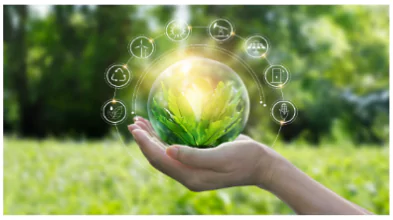India’s green economy is expanding at an unprecedented pace positioning India as a global leader in the green transition.
Green Economy

- The green economy is an economic framework that integrates considerations for the environment and sustainability into economic growth.
- It aims to generate economic development and job creation while ensuring that we don’t deplete the planet’s natural resources.
- The UN defines the green economy as “low carbon, resource efficient and socially inclusive.”
Difference from Traditional Economy
- The traditional economies prioritize short-term growth, often at the expense of the environment.
- The green economy seeks long-term sustainable development by aligning economic, ecological, and social goals.
Key Features of the Green Economy
- Low Carbon: Emphasizes reducing greenhouse gas emissions through renewable energy, energy efficiency, and sustainable transport.
- India is the 3rd largest renewable energy producer globally with over 220 GW of installed renewable capacity as of April 2025.
- Resource Efficiency: Promotes the efficient use of natural resources like water, energy, and raw materials to reduce waste and pollution.
- Ban on single use plastics, Extended Producer Responsibility obligates companies to manage the lifecycle of their products.
- Social Inclusion: Ensures fair access to opportunities and benefits, aiming to eliminate poverty and inequality.
- As per the ILO, transition to the green economy could create 24 million jobs globally by 2030
- Sustainable Development: Integrates environmental sustainability with economic growth and job creation.
- Sustainable agriculture, like Zero Budget Natural Farming, reduces chemical usage and boosts income
- Nature-based Solutions: Uses ecosystem-based approaches (like afforestation, wetland conservation) to address climate and development challenges.
- India has pledged to restore 26 million hectares of degraded land by 2030 under Bonn challenge.
What is Green GDP?
- Green Gross Domestic Product (Green GDP) is an alternative economic metric that adjusts traditional GDP by factoring in environmental costs associated with economic growth.
- Unlike conventional GDP which measures only the total value of goods and services produced, Green GDP subtracts the negative environmental impacts of that production .
- The formula for Green GDP is:
- Green GDP = GDP – Environmental Costs – Social Costs
- Environmental costs typically include:
- Depletion of natural resources (oil, coal, natural gas, wood, metals)
- Degradation of ecological systems (water pollution, soil erosion, biodiversity loss)
- Restoration costs for damaged environments (waste recycling, wetland restoration)
- Social costs include:
- Poverty resulting from environmental degradation
- Increased healthcare expenditures due to pollution
Green National Accounts
- Green National Accounts expand traditional national accounting systems to include environmental assets and their depletion.
- Several countries have experimented with green accounting:
- China: Pioneered Green accounting adoption in 2004 but later abandoned it.
- European Union: Uses SEEA frameworks through its “Beyond GDP” initiative.
Global Green Economy Index
- The Global Green Economy Index (GGEI) measures the green economy performance of 160 countries across 18 indicators.
- The GGEI was the first green economy index, launched in 2010.
- It was developed by Dual Citizen LLC.
- The GGEI is defined by four key dimensions:
- climate change & social equity,
- sector decarbonization,
- markets & ESG investment, and
- environmental health.
|
Green Economy Growth in India
- India’s green economy is projected to reach $1 trillion by 2030 and $15 trillion by 2070.
- This growth is supported by increased investment in renewable energy, EVs, sustainable infrastructure, and technology.
- Green Jobs: India is expected to create 7.29 million green jobs by FY2027-28 and 35 million green jobs by 2047.
- Jobs are expanding beyond traditional roles into new-age green careers.
- A study by the Council on Energy, Environment and Water (CEEW) shows that Odisha’s green economy alone has a market potential of $23 billion.
Green Economy & Women Participation
- Low Participation: Only 18% of start-ups are led by women, limiting green innovation potential.
- Finance Gaps: Women entrepreneurs in green sectors face significant financing challenges. 79% of women-led enterprises were self-financed, and only 1.1% accessed loans from financial institutions.
- Need for Inclusive Schemes: Govt loans like the ₹2 crore scheme for SC/ST women are steps forward, but more such support is needed.
- Mentorship Matters: Women lack access to targeted mentorship and role models in green sectors.
- Platforms like the Women Entrepreneurship Platform (NITI Aayog) and Goldman Sachs–IIMB programmes provide a foundation, but wider corporate-backed training and boot camps are necessary to scale impact.
- Engineering Gap: Women make up only 19.2% of engineering students, affecting entry into green tech roles.
- Essential for 2047 Goals: Empowering women in green businesses is not just a matter of equity—it is vital for India’s goal of becoming a sustainable, developed nation by 2047.
Government Initiatives to boost Green Economy
- National Green Hydrogen Mission: Aims to make India a global hub for green hydrogen production (5 MMT/year by 2030) and cut fossil fuel import.
- Green Credit Programme: Incentivizes eco-friendly actions by companies/individuals under the Environment Act, mobilizing resources for sustainability projects .
- PM-PRANAM & GOBARdhan Scheme: PM-PRANAM promotes alternative fertilizers; GOBARdhan builds 500 waste-to-wealth plants (₹10,000 crore) for the circular economy .
- FAME India & PM E-DRIVE Scheme: Boosts EV adoption via subsidies (FAME) and a $1.3B incentive pool (E-DRIVE) for cleaner mobility .
- National Cooling Action Plan (NCAP): Targets sustainable cooling via energy efficiency, refrigerant phase-down, and heat resilience (aligned with net-zero goals).
|
Geographic Spread of Green Jobs
- Major green job hubs: Mumbai, Bengaluru, Delhi
- Emerging hubs in Tier II and III cities: Jaipur, Indore, Vizag, Coimbatore, Bhubaneswar, Chandigarh, Ahmedabad
- These smaller cities could account for 35–40% of green jobs by FY28, driven by sustainable agriculture, logistics, and warehousing.
Sectors Driving the Green Economy
- Renewable energy (solar, wind, hydro)
- Electric vehicles and green transport
- Waste management and recycling
- Sustainable agriculture
- Green construction and urban planning
- Clean manufacturing and circular economy
Significance of the Green Economy
- Reduces Pollution & Emissions: Promotes clean energy, green mobility, and waste reduction, directly cutting greenhouse gas emissions.
- The International Council on Clean Transportation (ICCT) found that EVs produce 50-60% fewer lifetime emissions than petrol cars.
- Climate Change Mitigation and Adaptation: The green economy aligns with global climate goals like the Paris Agreement, helping countries limit warming to below 2°C.
- India’s Action Plans on Climate Change integrate green economy principles.
- Economic Growth and Innovation: Drives sustainable industrialization and innovation in sectors like renewable energy, electric vehicles, sustainable agriculture, and green buildings.
- India’s green economy is projected to grow to $1 trillion by 2030 and $15 trillion by 2070.
- Resource Efficiency and Circular Economy: Reduces overuse and wastage of water, minerals, and energy through recycling, reuse, and sustainable production.
- EU Circular Economy Action Plan aims to double circular material use rates by 2030, reducing virgin resource dependency.
- Social Inclusion and Poverty Reduction: Empowers rural and vulnerable communities through nature-based livelihoods and clean energy access.
- Solar microgrids in rural India have improved power access for millions of households, enhancing education and livelihoods.
Challenges to the Green Economy
- High Initial Investment Costs: Transitioning to green infrastructure (solar, wind, EVs, etc.) requires large upfront capital.
- Technological Gaps and Infrastructure Deficits: Lack of access to advanced green technologies, especially in low-income nations.
- Inadequate infrastructure (e.g., EV charging stations, smart grids) hinders adoption.
- Resistance from Established Industries: Traditional sectors like coal, oil, and automobile manufacturing resist the green shift due to fear of job losses and sunk investments.
- Coal accounts for ~70% of India’s electricity—phasing it out affects millions of livelihoods.
- Skilling and Employment Transition: Green economy demands new skill sets (e.g., solar technicians, battery engineers), but workforce retraining is slow.
- ILO estimates that 6 million jobs could be lost in carbon-intensive sectors globally by 2030.
- Social and Equity Issues: Risk of deepening inequality if green solutions are unaffordable for poor communities.
- Rooftop solar adoption in urban India is much higher than in rural or marginalized regions.
- Geopolitical and Trade Barriers: Green technologies are caught in global trade politics—e.g., anti-dumping duties, rare earth mineral dependencies.
- Renewable energy security now involves securing lithium, cobalt, etc., largely controlled by a few countries (e.g., China, DRC).
Way Forward
- Enhance Green Financing Mechanisms: Establish dedicated green banks, sovereign green bonds, and blended finance models.
- India issued its first ₹8,000 crore sovereign green bond in 2023, supporting solar, wind, and green hydrogen projects.
- Develop Robust Green Infrastructure: Rapid expansion of EV charging stations, renewable energy grids, and waste-to-energy plants is essential.
- India’s National Electric Mobility Mission aims for 30% EV penetration by 2030, requiring massive infrastructure scaling.
- Support Just Transition for Workers: Launch large-scale retraining programs for fossil fuel workers.
- ILO recommends a “just transition” approach, India can adapt this by integrating green skills in schemes like Skill India Mission.
- Build Domestic Supply Chains: Invest in domestic manufacturing of solar cells, batteries, and wind components under PLI (Production Linked Incentive) schemes.
- Reduce reliance on imports by securing minerals through partnerships (e.g., India-Australia MoU on critical minerals, 2023).
- International Cooperation and Technology Transfer: Leverage platforms like International Solar Alliance and G20 green initiatives to access climate finance and clean tech.
Conclusion
The green economy is not just about protecting the environment, it’s a strategic imperative for sustainable growth, job creation, poverty alleviation, and global competitiveness. For India, it offers a vital framework to achieve Viksit Bharat 2047, meet climate targets, and ensure intergenerational equity.
![]() 5 Jun 2025
5 Jun 2025


